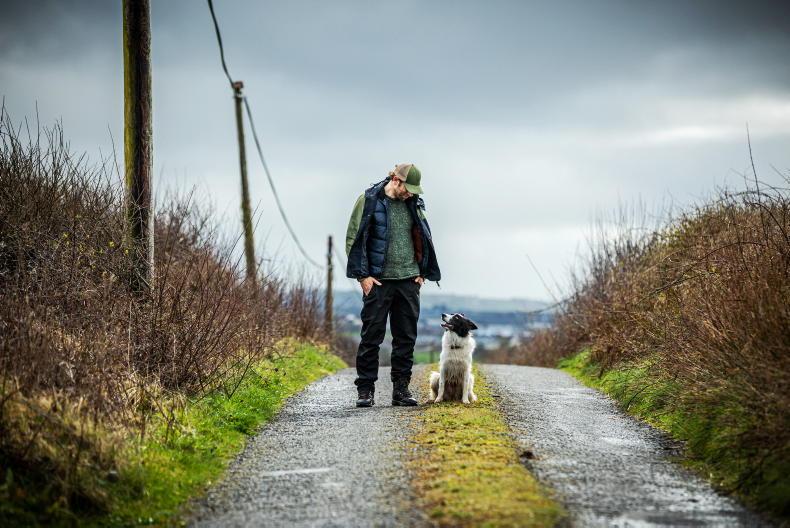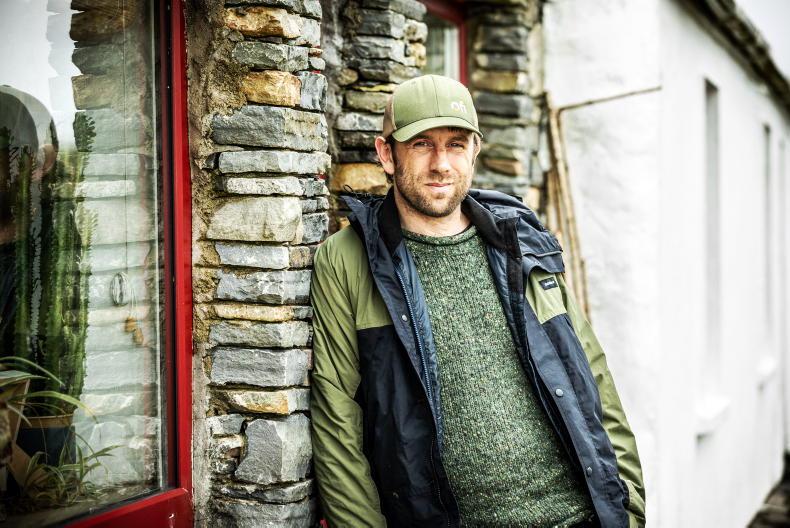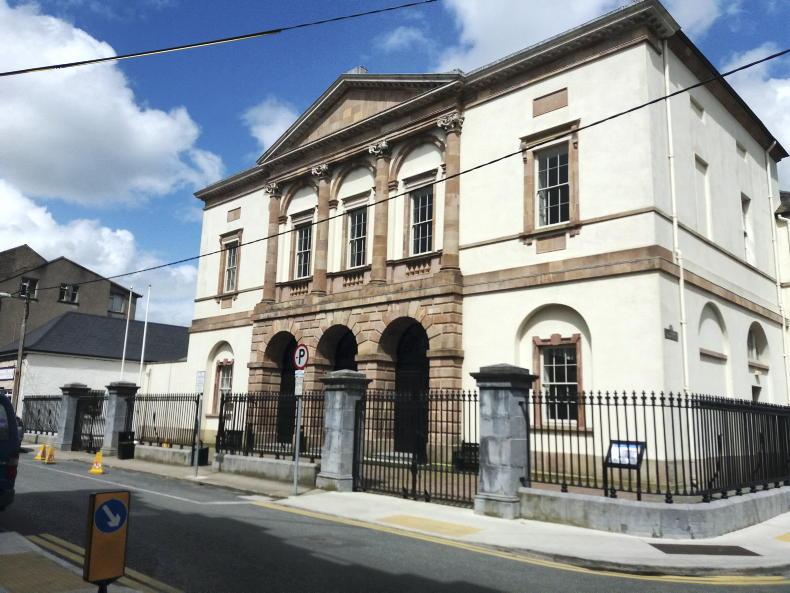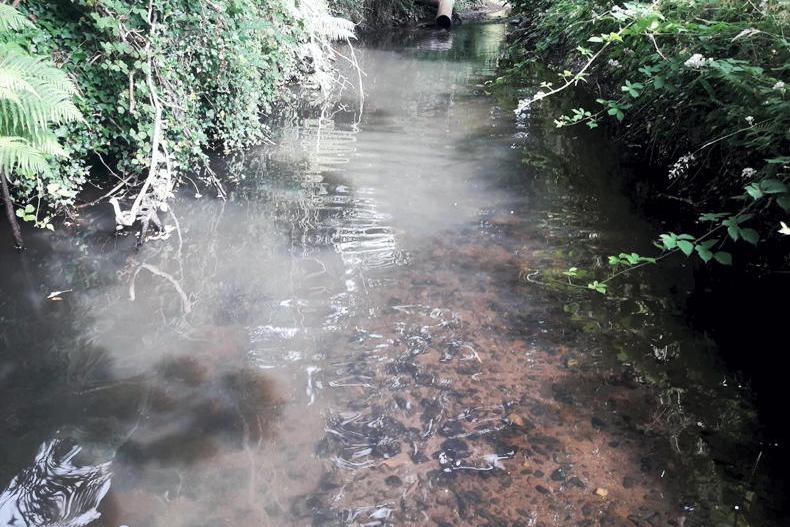If you ever have the pleasure of visiting Ray Ó Foghlú, don’t make the mistake I made. Approaching his cottage along the kind of boreen where both wingmirrors are touching the hedges, I stopped to ask an elderly gentleman if I was on the right path.
My mistake was to not close my window after receiving the reassurance I required.
So when I pulled into his yard 50 meters later, a very boisterous collie – who I later learned goes by the name Tara – took a short run and jumped clear into the car, landed on my lap and put a sudden halt to any further progress. And completely ruining any chance of maintaining any air of professionalism.
Having extracted myself from both the car and the collie, I took a moment to take in the scene.
The cottage is of the type found all along the west coast. This particular example, outside Miltown Malbay, Co Clare, has solar panels on the roof and what are clearly new doors and windows. The yard suggests whatever work is being done on the building is not yet finished.
Ray opens the door and welcomes me – and Tara – into his kitchen. He’s wearing the kind of chunky knit jumper that is so often favoured by environmentalists, but before I manage to pigeonhole him as a possible crank he offers me a coffee with real milk and sits down to show he’s actually properly thought about the challenges facing agricultural, environmental and forestry policy in Ireland.
“What farmers choose to do or choose not to do in relation to forestry in Ireland is the factor that will decide whether we succeed or fail in this country.
“Farmers own 70% of the land. They are the key stakeholder and the key to successful forestry policy.”
This idea is the central one of Ray’s study as a 2021 Nuffield scholar. The topic “acquiring social licence to increase tree cover on the Irish landscape” looked into attitudes to forestry in Ireland and tries to find a path forward to which has broad-based support from farmers and their communities as well as environment advocates.
“There are plenty of environmentalist out there who are so busy trying to be right that they completely forget to be effective,” Ray says, without mentioning any names.
“Farmers are not against trees, but the way forestry has been sold to them down the years does little to help them engage with the process. It has been what I jokingly refer to as policy-by-PDF.
“A plan is made and published and there seems to be a sense in some quarters that that is enough. But there has to be acknowledgement that the decision to plant trees is a big one for any farmer.
“They need to be supported through the process and, importantly, need to be given options that are more flexible and useful in real-world situations.
“We have a project [the Hometree Charity] here where we have 12 farmers in the area that have seen the value in creating a woodland area that stretches across their lands.
“Running between their fields are these beautiful oak stands that cling on in river valleys, and we’re working with those farmers to expand and connect those woodlands. But doing so in a way that enhances the farming practices already undertaken on the land by improving water quality, providing shelter for animals and helping water attenuation.”
Licences
“All but one of those farmers has applied for licences to plant a combined 100 acres of woodland, which is a huge success. For us, it is a proof of concept.
“It shows that farmers are open to the right kind of forestry presented in the right way, and critically with the right supports in place.”

Ray Ó Foghlú with his collie, Tara. \ Philip Doyle
Ray bringing up mention of the “right supports” gives me the chance to ask him about how he would rate forestry policy in Ireland over the past decade or so.
People underestimate the impact bad policy can have
Looking from the outside, it seems policy effectiveness speaks for itself, with the country last planting more than 8,000ha in one year in 2010. In 2021, there was a total of 2,000ha of new forest planted, with farmers only accounting for 390ha.
“People underestimate the impact bad policy can have. Twenty years ago, farmers were generally well disposed to planting trees. Then there were some cuts to grants and the disaster that is ash dieback arrived in the country.
“It was bad luck that Ireland’s ash trees have been wiped out by this disease. However, the reaction to that disaster has been completely within the gift of the State.
“I know farmers who have plantations of ash and they tell me they can’t even walk into that part of their farm. They would love for nothing more than to clear it and start again, but they can’t get a licence to clearfell.
“The State could have come in when the scale of the wipeout became apparent and introduced a compensation and redress scheme, but they sat on their hands.
“Bad news travels fast, and for many in the farming community, trees are now bad news. The State has made it clear it will help you plant, but if anything goes wrong, you are on your own. They should not be surprised that nobody else is signing up now.”

Ray Ó Foghlú. \ Philip Doyle
For reference, the Irish Government’s target for forestry is 8,000ha per year between now and 2030.
“Look, the Green Party get a lot of flack over the state of forestry policy here, and I used to defend them. They inherited an absolute sh*tshow. But, now, after a few years at the helm, they have to own the real lack of progress.”
“The grants have improved in the latest scheme, but it still can’t compete against dairy or solar or other options where the return is probably better.
“For the Greens, they have to realise that all the bad feeling towards forestry means they are mostly competing on price for farmers.
“The goodwill that was there 20 years has been destroyed by terrible policy decisions down the years, or the complete lack of policy response to challenges when they arise.”
Whatever about competing on price, there is also the argument about policy – does Ireland want to be a global leader in the production of high-quality food, or does it want to be a beautiful parkland?
In food production, acres and acres of single crop grass is bad policy
Ray rejects that choice, saying: “we are very prolific food producers in some areas, and dairy springs to mind here, but I don’t think we can accept that there is no space for balance. In forestry, the idea of acres and acres of spruce trees is bad policy.
“Similarly, in food production, acres and acres of single crop grass is bad policy.
“The idea that is either one or the other on food and nature is also something I object to. There is room for nature and very intensive farming, not only in Ireland, but on a single farm and in a single field. The role of technology is also going to be huge as we face the challenges of environment protection and food production.
“To those who say we have to make a choice, I ask, why not both?”
“We started out with the ambition to create permanent native woodland in Ireland. Since we started, we have expanded and turned into an eco-system restoration charity. Trees are not always the right answer, it’s horses for courses. Crucially, we have a very strong philosophy around working with the community and in partnership with farmers.
“We have a project, the Wild Atlantic Rainforest, where we are planning to restore 4,000 acres of land back to its natural woodland state. But, as Matt Smith (CEO of Hometree) says, 4,000 acres in a country of 20m acres is a tiny drop in the ocean.
“Hometree neither wants nor needs to own a load of land.
“The main focus for the charity is to talk to and help farmers improve their own environment. Government policy has generally been to rely on farmer altruism to achieve anything more than the minimum requirement.
“We put money on the table for farmers up front [€1,000/ha for native woodland]and provide further financial help for them to get the right scheme in place.
“Basically, we are showing there is a need for financial support, but farmers also genuinely have an interest in nature. The enthusiasm for doing something to help is there, it just needs to be properly supported. And that’s a lot of what Hometree is about.”
If you ever have the pleasure of visiting Ray Ó Foghlú, don’t make the mistake I made. Approaching his cottage along the kind of boreen where both wingmirrors are touching the hedges, I stopped to ask an elderly gentleman if I was on the right path.
My mistake was to not close my window after receiving the reassurance I required.
So when I pulled into his yard 50 meters later, a very boisterous collie – who I later learned goes by the name Tara – took a short run and jumped clear into the car, landed on my lap and put a sudden halt to any further progress. And completely ruining any chance of maintaining any air of professionalism.
Having extracted myself from both the car and the collie, I took a moment to take in the scene.
The cottage is of the type found all along the west coast. This particular example, outside Miltown Malbay, Co Clare, has solar panels on the roof and what are clearly new doors and windows. The yard suggests whatever work is being done on the building is not yet finished.
Ray opens the door and welcomes me – and Tara – into his kitchen. He’s wearing the kind of chunky knit jumper that is so often favoured by environmentalists, but before I manage to pigeonhole him as a possible crank he offers me a coffee with real milk and sits down to show he’s actually properly thought about the challenges facing agricultural, environmental and forestry policy in Ireland.
“What farmers choose to do or choose not to do in relation to forestry in Ireland is the factor that will decide whether we succeed or fail in this country.
“Farmers own 70% of the land. They are the key stakeholder and the key to successful forestry policy.”
This idea is the central one of Ray’s study as a 2021 Nuffield scholar. The topic “acquiring social licence to increase tree cover on the Irish landscape” looked into attitudes to forestry in Ireland and tries to find a path forward to which has broad-based support from farmers and their communities as well as environment advocates.
“There are plenty of environmentalist out there who are so busy trying to be right that they completely forget to be effective,” Ray says, without mentioning any names.
“Farmers are not against trees, but the way forestry has been sold to them down the years does little to help them engage with the process. It has been what I jokingly refer to as policy-by-PDF.
“A plan is made and published and there seems to be a sense in some quarters that that is enough. But there has to be acknowledgement that the decision to plant trees is a big one for any farmer.
“They need to be supported through the process and, importantly, need to be given options that are more flexible and useful in real-world situations.
“We have a project [the Hometree Charity] here where we have 12 farmers in the area that have seen the value in creating a woodland area that stretches across their lands.
“Running between their fields are these beautiful oak stands that cling on in river valleys, and we’re working with those farmers to expand and connect those woodlands. But doing so in a way that enhances the farming practices already undertaken on the land by improving water quality, providing shelter for animals and helping water attenuation.”
Licences
“All but one of those farmers has applied for licences to plant a combined 100 acres of woodland, which is a huge success. For us, it is a proof of concept.
“It shows that farmers are open to the right kind of forestry presented in the right way, and critically with the right supports in place.”

Ray Ó Foghlú with his collie, Tara. \ Philip Doyle
Ray bringing up mention of the “right supports” gives me the chance to ask him about how he would rate forestry policy in Ireland over the past decade or so.
People underestimate the impact bad policy can have
Looking from the outside, it seems policy effectiveness speaks for itself, with the country last planting more than 8,000ha in one year in 2010. In 2021, there was a total of 2,000ha of new forest planted, with farmers only accounting for 390ha.
“People underestimate the impact bad policy can have. Twenty years ago, farmers were generally well disposed to planting trees. Then there were some cuts to grants and the disaster that is ash dieback arrived in the country.
“It was bad luck that Ireland’s ash trees have been wiped out by this disease. However, the reaction to that disaster has been completely within the gift of the State.
“I know farmers who have plantations of ash and they tell me they can’t even walk into that part of their farm. They would love for nothing more than to clear it and start again, but they can’t get a licence to clearfell.
“The State could have come in when the scale of the wipeout became apparent and introduced a compensation and redress scheme, but they sat on their hands.
“Bad news travels fast, and for many in the farming community, trees are now bad news. The State has made it clear it will help you plant, but if anything goes wrong, you are on your own. They should not be surprised that nobody else is signing up now.”

Ray Ó Foghlú. \ Philip Doyle
For reference, the Irish Government’s target for forestry is 8,000ha per year between now and 2030.
“Look, the Green Party get a lot of flack over the state of forestry policy here, and I used to defend them. They inherited an absolute sh*tshow. But, now, after a few years at the helm, they have to own the real lack of progress.”
“The grants have improved in the latest scheme, but it still can’t compete against dairy or solar or other options where the return is probably better.
“For the Greens, they have to realise that all the bad feeling towards forestry means they are mostly competing on price for farmers.
“The goodwill that was there 20 years has been destroyed by terrible policy decisions down the years, or the complete lack of policy response to challenges when they arise.”
Whatever about competing on price, there is also the argument about policy – does Ireland want to be a global leader in the production of high-quality food, or does it want to be a beautiful parkland?
In food production, acres and acres of single crop grass is bad policy
Ray rejects that choice, saying: “we are very prolific food producers in some areas, and dairy springs to mind here, but I don’t think we can accept that there is no space for balance. In forestry, the idea of acres and acres of spruce trees is bad policy.
“Similarly, in food production, acres and acres of single crop grass is bad policy.
“The idea that is either one or the other on food and nature is also something I object to. There is room for nature and very intensive farming, not only in Ireland, but on a single farm and in a single field. The role of technology is also going to be huge as we face the challenges of environment protection and food production.
“To those who say we have to make a choice, I ask, why not both?”
“We started out with the ambition to create permanent native woodland in Ireland. Since we started, we have expanded and turned into an eco-system restoration charity. Trees are not always the right answer, it’s horses for courses. Crucially, we have a very strong philosophy around working with the community and in partnership with farmers.
“We have a project, the Wild Atlantic Rainforest, where we are planning to restore 4,000 acres of land back to its natural woodland state. But, as Matt Smith (CEO of Hometree) says, 4,000 acres in a country of 20m acres is a tiny drop in the ocean.
“Hometree neither wants nor needs to own a load of land.
“The main focus for the charity is to talk to and help farmers improve their own environment. Government policy has generally been to rely on farmer altruism to achieve anything more than the minimum requirement.
“We put money on the table for farmers up front [€1,000/ha for native woodland]and provide further financial help for them to get the right scheme in place.
“Basically, we are showing there is a need for financial support, but farmers also genuinely have an interest in nature. The enthusiasm for doing something to help is there, it just needs to be properly supported. And that’s a lot of what Hometree is about.”













SHARING OPTIONS